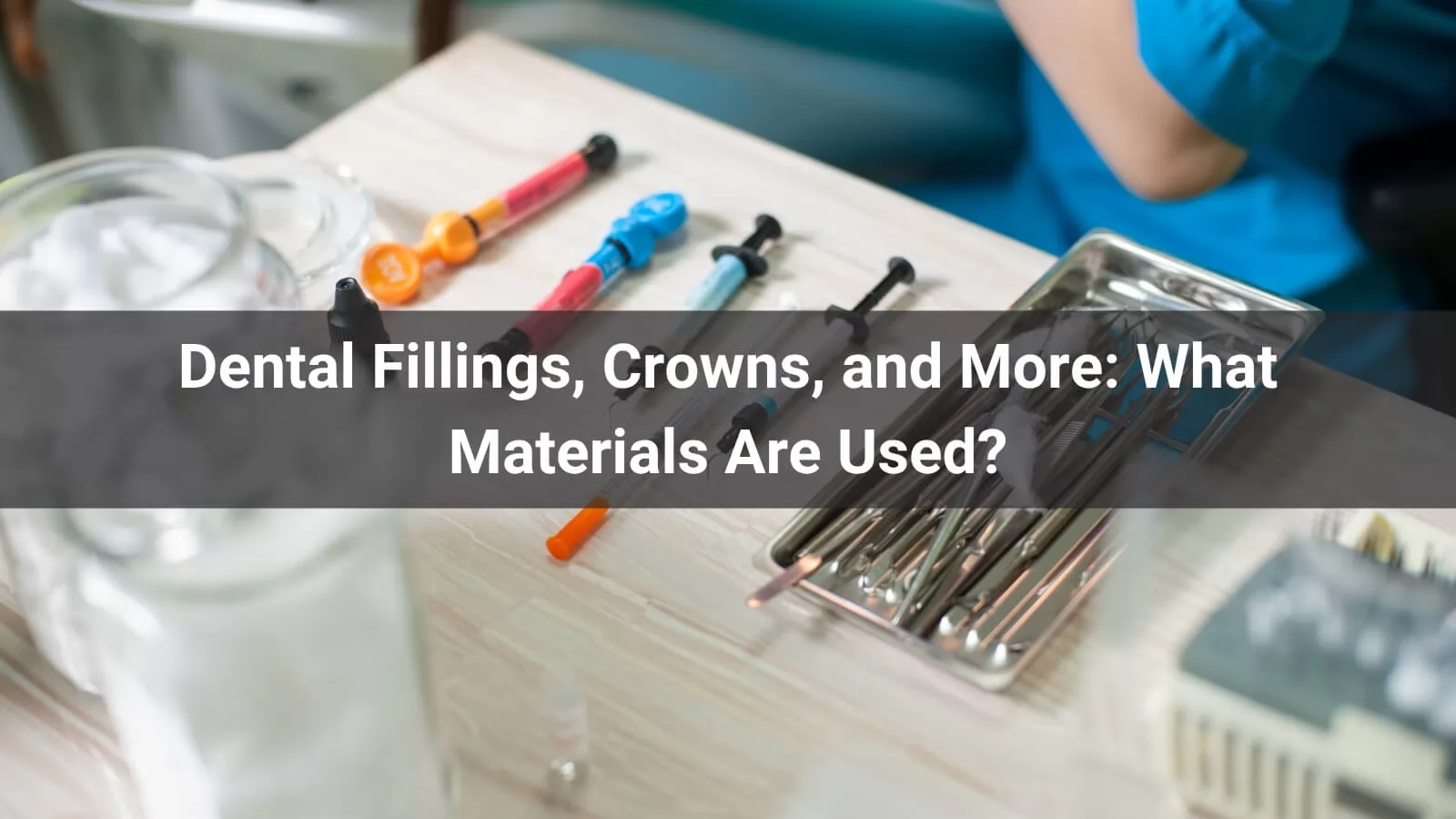
What are dental fillings really made of? Why do some crowns look just like real teeth while others don’t? And how do you know which material is right for you? If you've ever sat in the dentist’s chair wondering what exactly is going into your mouth, you're not alone. Dental restorations may seem routine, but the materials used can make a big difference in comfort, appearance, and longevity.
In modern dentistry, materials like composite resin, porcelain, gold, and amalgam are commonly used for fillings, crowns, and other restorations. Each has its own advantages and ideal applications—composites blend naturally with teeth, metals are incredibly durable, and ceramics offer a lifelike appearance.
This article explores the key materials used in dental restorations, their properties, and when each is typically recommended. Read on to gain insight into how your dentist chooses the best option for your smile—and what it means for your long-term oral health.
Classification and Overview of Dental Materials
1. Resin Composites
-
Matrix: Bis-GMA, UDMA, or related dimethacrylate monomers
-
Fillers: Silica, zirconia, or glass particles for strength and wear resistance
-
Coupling agents: Silane agents that enhance adhesion between filler and resin
Resin composites are widely used in fillings and cosmetic restorations. They are made of a plastic-like matrix (such as Bis-GMA or UDMA), fine fillers like glass or zirconia particles, and special agents that help bind everything together.
The main advantage of resin composites is that they look very natural and blend well with real teeth. They also allow for minimal drilling and can bond strongly to the tooth surface. However, they can shrink slightly when they harden, which may cause small gaps or sensitivity. Over time, they can also wear down or become stained.
2. Glass Ionomer Cements (GICs)
-
Liquid: Polyalkenoic acid
-
Powder: Fluoroaluminosilicate glass
Glass ionomers are commonly used in fillings, especially in children or non-load bearing areas. They are made of a mix of glass powder and a special acidic liquid that sets through a chemical reaction.
Their biggest benefit is that they release fluoride, which helps protect against cavities. They also stick to teeth without the need for strong adhesives. But they are not as strong or long-lasting as resin composites, and they can wear down more easily with chewing over time.
3. Dental Ceramics
-
Feldspathic porcelain: Excellent translucency, ideal for veneers, but brittle
-
Leucite-reinforced ceramic: Improved strength with good esthetics
-
Lithium disilicate: High strength and lifelike appearance, suitable for crowns and inlays
-
Zirconia (Y-TZP): Extremely strong and durable, ideal for posterior crowns and bridges
Dental ceramics are used for crowns, veneers, and bridges because of their excellent appearance and strength. Common types include feldspathic porcelain, lithium disilicate, and zirconia.
Ceramics are very strong, resistant to staining, and look very natural, making them ideal for visible areas. They are also safe for the body and don't cause irritation. On the downside, some ceramics can be brittle and may chip if not handled carefully. They are also harder than natural teeth and might wear down the opposing tooth if not polished properly.
4. Metal Alloys
-
High-noble alloys: Gold, platinum – corrosion resistant and biocompatible
-
Base-metal alloys: Nickel-chromium, cobalt-chromium – affordable and durable
-
Titanium: Lightweight, corrosion-resistant, ideal for dental implants
Metal alloys have been used in dentistry for decades and are known for their strength and durability. These include gold, nickel-chromium, cobalt-chromium, and titanium.
Their strength and long-lasting performance make them ideal for bridges, crowns, and implants, especially in back teeth. They rarely break and are highly resistant to corrosion. However, they don’t match the natural tooth color and may cause allergic reactions in some people, especially with base metals like nickel.
5. Emerging and Specialty Materials
-
Bioactive glass: Promotes remineralization and healing of tooth structure
-
Nanocomposites: Incorporate nanoparticles for superior polish, wear resistance, and strength
-
Hybrid ceramics: Combine ceramic and resin properties, offering flexibility and esthetics
Newer dental materials are being developed to offer even better performance. These include bioactive glass, nanocomposites, and hybrid ceramics.
These advanced materials can help teeth repair themselves, offer better strength, and look very natural. They also work well with modern digital dental tools. But they can be more expensive and may require special training or equipment to use properly.
OVO offers a complete range of high-quality dental materials, from traditional to cutting-edge solutions. Visit our Products page to explore options that match your needs. Work with OVO to ensure safe, effective, and modern dental care.
Selection Criteria for Dental Materials
Choosing the right material requires balancing multiple factors to meet clinical and aesthetic goals:
-
Biocompatibility: Materials must not irritate or harm oral tissues.
-
Mechanical Properties: Adequate strength, fracture toughness, and wear resistance.
-
Aesthetics: Color match, translucency, and polishability for natural-looking restorations.
-
Longevity: Resistance to degradation, corrosion, and staining over time.
-
Handling Characteristics: Ease of placement, working time, and curing method.
-
Cost-effectiveness: Balancing material performance with affordability for patients and practices.
At OVO, we offer detailed material data sheets and expert support to help you select the ideal product for each indication. Please contact us for technical specifications and case studies.
Recent Advances and Future Trends
1. Nanotechnology Integration
Nanofillers enhance mechanical strength and polishability. These ultra-fine particles improve wear resistance while maintaining excellent aesthetics.
2. 3D-Printed Restorations
Digital workflows now enable additive manufacturing of crowns, bridges, and surgical guides with high precision and reduced turnaround time.
3. Bioactive and Smart Materials
Emerging bioactive glasses and resin formulations can release ions to encourage remineralization and inhibit bacterial growth.
4. High-Strength Zirconia Innovations
New generations of multilayer zirconia offer improved translucency without sacrificing toughness, ideal for full-contour esthetic restorations.
FAQs About Dental Materials
1. What are the most commonly used dental materials?
The most common dental materials include resin composites, glass ionomer cements, ceramics (like zirconia and lithium disilicate), and metal alloys. Each is selected based on the specific clinical need, durability, and aesthetic requirements.
2. Which dental material is best for fillings?
Composite resins are typically preferred for aesthetic fillings due to their tooth-like appearance and bonding properties. For deeper cavities or areas under high stress, glass ionomers or amalgam may also be considered.
3. Are all dental materials safe?
Yes, modern dental materials are rigorously tested for biocompatibility. OVO ensures all products meet global safety and quality standards, minimizing allergic reactions and ensuring long-term performance.
4. How long do dental materials last?
Longevity depends on the material type, placement technique, and oral hygiene. For example, ceramic crowns can last 10–15 years or longer, while composite fillings may need replacement after 5–7 years.
5. Can dental materials cause allergies?
While rare, some patients may experience reactions to metals (like nickel) or monomers in certain resins. OVO offers hypoallergenic alternatives to ensure safe use for all patients.
Conclusion
Understanding the wide range of dental materials and their properties is essential for delivering durable, esthetic restorations. By considering biocompatibility, mechanical strength, aesthetics, and cost, you can select the most suitable material for each clinical scenario.
OVO stands ready to support your practice or business with high-quality composites, ceramics, metals, and advanced bioactive solutions. Explore our full catalog and let’s innovate restorative dentistry together.
Contact OVO today to learn more about partnership opportunities, request samples, or schedule a product demo.



